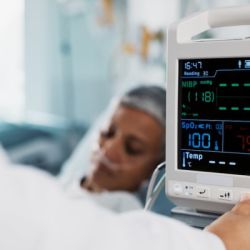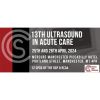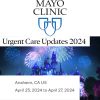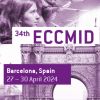ICU Management & Practice, Volume 22 - Issue 5, 2022
Echocardiography in the ICU
Echocardiography is currently considered an essential diagnostic tool at the disposal of the intensivist – a significant change from less than two decades ago when editorials were still advocating for its uptake by critical care physicians (Cholley et al. 2006). Previously a service mainly delivered by cardiologists, echocardiography is now regularly performed by intensivists at the bedside, often as a goal-directed ultrasound examination to hasten the diagnostic process or to monitor haemodynamics. The uptake of ultrasound in common critical care practice is reflected in the development of multiple international guidelines and recommendations delineating the scope of critical care ultrasound and the required competencies for those performing it (Levitov et al. 2016; Wong et al. 2020; Kirkpatrick et al. 2020; Mayo et al. 2009; Expert Round Table on Echocardiography 2014).
This paper will review the current applications and limitations of ultrasound in the critical care context and will conclude with a recommendation on how to determine the appropriate modality of ultrasound for a specific patient.
Terminology
Critical Care Echocardiography (CCE) has been suggested as an umbrella term for all echocardiography performed by intensivists. It can be divided into basic and advanced CCE, where both include transthoracic and transoesophageal modalities (Vieillard-Baron et al. 2019). Two terms frequently applied to describe a goal-directed ultrasound examination performed according to a standardised but limited scanning protocol are FoCUS (Focused Cardiac Ultrasound) (Neskovic et al. 2018; Via et al. 2014) and PoCUS (Point of Care Cardiac Ultrasound). However, definitions and scope vary across the literature. Other protocols developed were FATE – an abbreviated (Focus Assessed Transthoracic Echocardiographic) protocol for screening and monitoring (Jensen et al. 2004), FICE (Focused Intensive Care Echocardiography), FUSIC (Focused Ultrasound in Intensive Care), RUSH (Rapid Ultrasound for Shock and Hypotension), and many more. The American Society of Echocardiography (ASE) differentiates between ultrasound-assisted physical examination (UAPE), cardiac POCUS, critical care echocardiography (CCE), and standard transthoracic echocardiography. The ASE offers definitions for these terms, which include diagnostic expectations, application frequency, interpretation of findings, quantification, indication, and documentation for the different modalities (Kirkpatrick et al. 2020). They detail the necessary teaching requirements, ranging from weeks (UAPE) to years (standard transthoracic echocardiography).
The myriad of terms utilised to describe cardiac ultrasounds performed by intensivists and the lack of standardised, universally accepted definitions for the different modalities pose specific challenges – both in their practical application and in developing training programmes and competency assessments. The lack of a standard curriculum for ultrasound training in critical care (Kanji et al. 2016) and the variability in curriculum content and accreditation pathways (Wong et al. 2019) can compromise the quality of critical care ultrasound delivered in daily practice.
Basic Critical Care Echocardiography
A limited imaging protocol – as is the case in UAPE, basic CCE, FoCUS, or PoCUS - is designed to answer simple questions (e.g., basic assessment of ventricular function, presence or absence of a pericardial effusion) and guide immediate management. The clinician performing the examination should have the competency to acquire and interpret the findings and integrate them within the clinical context. The operator should specify which ultrasound protocol was chosen and understand its inherent limitations. Significant findings might be missed when performing a restricted ultrasound protocol due to the intrinsic shortcomings of basic CCE (e.g., no assessment of valvular pathologies nor use of Doppler modalities) (Douflé et al. 2022; Falaye and Gershon 2017) and the limited experience of the sonographer (Adhikari et al. 2014; Rajamani et al. 2020). Unfortunately, there is a paucity of literature assessing the frequency of missed findings when applying limited ultrasound modalities; the review of images acquired with basic CCE, PoCUS, or FoCUS is further complicated by the fact that they are not routinely recorded; they may be performed after-hours and findings are usually documented in the form of a chart note. The lack of systematic review by clinicians with advanced knowledge of ultrasound leads to a lost opportunity for ongoing feedback. In addition, not all basic ultrasound examinations are followed by a standard echocardiographic study, which could uncover pathologies missed during the initial assessment.
Without the competency to convert a limited imaging protocol to a comprehensive critical care echocardiogram, clinicians should exert caution when relying on basic ultrasound to guide clinical management. Restricted ultrasound protocols can rule in specific pathologies but ruling out a diagnosis might require advanced echocardiography. Advanced CCE should be considered a necessary modality to complement basic CCE in guiding the care of critically ill patients.
Advanced Critical Care Echocardiography
Advanced CCE requires echocardiography skills comparable to cardiologists' and the ability to convert a focused, limited examination into a comprehensive echocardiogram. Ideally, advanced CCE should include competency in both transthoracic (TTE) and transoesophageal (TEE) ultrasound since they each provide specific advantages. TTE is a non-invasive procedure and may allow a better alignment than TEE for Doppler modalities – for instance, when assessing the velocity of tricuspid regurgitation or measuring the Tricuspid Annular Plane Systolic Excursion (TAPSE). There are virtually no contraindications to performing a TTE; however, it requires a more extended training period, and image acquisition might be limited due to patient-specific characteristics, such as mechanical ventilation or prone positioning, making it a highly operator-dependent technique (Teran et al. 2020; Ugalde et al. 2018; Ugalde et al. 2022). TEE is less operator-dependent, can analyse structures not accessible through transthoracic echocardiography (Teran et al. 2020; Ugalde et al. 2018; Ugalde et al. 2022; Evrard et al. 2020), and provide additional information. Skills to perform a critical care TEE can be mastered in a shorter time (Charron et al. 2013). Being an invasive diagnostic modality, performing a transoesophageal echocardiogram is not without risk. However, complications in the critically ill population, with patients usually supported with mechanical ventilation, are rare and consist mainly of unintentional dislodgment of feeding tubes (Huttemann et al. 2004). The other possible risks intensivists performing TEE should be aware of are injury of the hypopharynx or the oesophagus.
The lack of readily available equipment can be a limitation for using TEE in the ICU. Not every unit has access to a dedicated transoesophageal echocardiography probe that can be cleaned rapidly and efficiently and deployed for multiple patients with a rapid turnover. In addition, since TEE is not yet part of all CCE curricula, competency and accreditation in the performance of TEE can be challenging to obtain for non-anaesthesia-trained intensive care physicians.
Applications of Critical Care Echocardiography
Aside of its use in the initial assessment on admission and the clinical examination, CCE can provide additional information in managing pathologies commonly encountered in the ICU. A transthoracic echocardiogram is usually performed first, with a subsequent transoesophageal echocardiogram if the transthoracic views are inadequate or insufficient to answer the clinical question. The use of transoesophageal echocardiography has been shown to change management in the critical care population (Garcia et al. 2017). For any given patient, a basic echocardiographic examination can assist in ruling in specific diagnoses – e.g., the presence of pericardial effusion or significant ventricular dysfunction – but might need to be followed by a comprehensive echocardiogram to ascertain the diagnosis or guide management.
Echocardiography in patients with shock
In patients with undifferentiated shock, echocardiography can assist in determining the underlying aetiology. Once the aetiology of shock is established, focused CCE can be repeated as needed to guide the patient’s management. Transoesophageal echocardiography plays a major role in the post-cardiac/thoracic surgery population as echogenicity may be limited in the immediate postoperative period. TEE may also identify subtle, localised pericardial effusion or haematoma, which might be missed on a TTE.
Echocardiography for haemodynamic monitoring
Most haemodynamic parameters can be estimated with the use of echocardiography (Narasimhan et al. 2014). Both TTE and TEE can additionally assist in the prediction of fluid responsiveness. Transoesophageal echocardiography may provide information on the respiratory variation of the diameter of the superior vena cava (ΔSVC), which has been shown to have the highest specificity for predicting fluid responsiveness when compared to the respiratory variations of the diameter of inferior vena cava (ΔIVC) and respiratory variations of the maximal Doppler velocity in the left ventricular outflow tract (ΔVmaxAo) (Vignon et al. 2017).
Echocardiography in respiratory failure and mechanical ventilation
CCE can identify cardiac causes of respiratory failure, assess heart-lung interactions, and assist in identifying aetiologies for weaning failure (Warraich et al. 2011; Mongodi et al. 2013; Tavazzi et al. 2016; Moschietto et al. 2012; Adamopoulos et al. 2005). In patients with ARDS, CCE can detect the presence of acute cor pulmonale and monitor how changes in mechanical ventilation parameters – like titration of PEEP, prone positioning, or recruitment manoeuvres - influence RV dysfunction (Repessé et al. 2016; Repessé et al. 2012; Chiumello and Pesenti 2013).
Echocardiography in monitoring patients on ECLS
Echocardiography is an essential monitoring tool for patients supported with ECLS – aiding in the pre-ECLS assessment, as a guidance during the cannulation process to ensure correct cannula positioning, assist in troubleshooting and/or avoiding potential complications. CCE is an invaluable monitoring tool once the patient is successfully cannulated (Morales-Castro et al. 2022; Douflé et al. 2015; Douflé et al. 2022).
Echocardiography in cardiac arrest
In cardiac arrest, echocardiography can help diagnose certain reversible causes and identify patients with pulseless electrical activity who are still exhibiting myocardial contractility (Flower et al. 2021; Price et al. 2010; Volpicelli 2011; Blyth et al. 2012; Blaivas and Fox 2001; Tsou et al. 2017; Breitkreutz et al. 2006; Breitkreutz et al. 2007). Besides establishing a diagnosis, TEE in cardiac arrest helps monitor the efficiency of cardiopulmonary resuscitation (Giorgetti et al. 2020; Yamagishi et al. 2018). It is important to note, however, that the use of TTE has been shown to prolong the duration of chest compression interruptions (Clattenburg et al. 2018). Therefore, only experienced practitioners should be performing the ultrasound in the setting of a cardiac arrest.
The Future
Echocardiography performed by intensivists has undoubtedly established its role in the care of the critically ill patient. However, there are still inconsistencies in terminology, scope, and required competencies.
The accuracy of image acquisition and interpretation is highly operator-dependent, especially if the operator is only trained in basic ultrasound modalities. A limited ultrasound protocol performed by a physician with advanced echocardiographic expertise is not equivalent to a restricted protocol performed by a physician with basic training. Physicians with advanced expertise can recognise subtle abnormalities (even from a limited protocol) and extend the examination when necessary. Furthermore, basic ultrasound examinations are usually insufficient to answer complex questions regarding underlying pathologies and haemodynamic interactions. At a minimum, images acquired during basic examinations should be saved and reviewed with someone proficient in advanced echocardiography – to adjudicate the accuracy of the study, to ensure that major findings were recognised, and to determine if a comprehensive examination, either as a TTE or a TEE, is required in the specific clinical context (Johri et al. 2020).
Basic and advanced CCE, including both transthoracic and transoesophageal approaches, should be regarded as a necessary complement in the ICU. In recent years, most ICU physicians have acquired some knowledge of basic image acquisition and interpretation. While most intensivists can be trained to perform basic echocardiography, not everyone will develop comprehensive knowledge and skills in advanced CCE. Thus, every intensive care unit should aim to have one or more trained and board-certified practitioners able to perform a comprehensive echocardiogram and supervise practitioners engaged in echocardiographic training (Cholley et al. 2006). Alternatively, close collaboration with cardiology or anaesthesiology may help provide ongoing expertise and training.
Conclusion
Echocardiography is an essential imaging modality for the critically ill, which is easy to apply, readily available, and with no or minimal risk for the patient. However, caution should be exerted when relying solely on findings from restricted imaging protocols. Basic and advanced cardiac ultrasound should be considered complementary modalities and, whilst not every individual intensivist needs to be trained in advanced echocardiography, every intensive care unit should be able to provide the full spectrum of echocardiographic examination (or closely collaborate with other specialties such as cardiology or anaesthesiology) to guide the care of the critically ill patient.
Conflict of Interest
None.
References:
Adamopoulos C,
Tsagourias M, Arvaniti K et al. (2005) Weaning failure from mechanical
ventilation due to hypertrophic obstructive cardiomyopathy. Intensive Care Med.
31:734-7.
Adhikari S,
Fiorello A, Stolz L et al. (2014) Ability of emergency physicians with advanced
echocardiographic experience at a single center to identify complex
echocardiographic abnormalities. Am J Emerg Med. 32:363-6.
Blaivas M, Fox
JC (2001) Outcome in Cardiac Arrest Patients Found to Have Cardiac Standstill
on the Bedside Emergency Department Echocardiogram. AcadEmerg Med. 8:616-21.
Blyth L,
Atkinson P, Gadd K, Lang E (2012) Bedside focused echocardiography as predictor
of survival in cardiac arrest patients: a systematic review. AcadEmerg Med.
19:1119-26.
Breitkreutz R,
Ilper H, Schalk R et al. (2006) ALS based intervals and interruptions in a two
rescuer CPR scenario: When to perform an ALS-conformed echocardiography during
resuscitation? Resuscitation. 70:302-3.
Breitkreutz R,
Walcher F, Seeger FH (2007) Focused echocardiographic evaluation in
resuscitation management: concept of an advanced life support-conformed
algorithm. Crit Care Med. 35:S150-61.
Charron C,
Vignon P, Prat G et al. (2013) Number of supervised studies required to reach
competence in advanced critical care transesophageal echocardiography.
Intensive Care Med. 39:1019-24.
Chiumello D,
Pesenti A (2013) The monitoring of acute cor pulmonale is still necessary in
"Berlin" ARDS patients. Intensive Care Med. 39:1864-6.
Cholley BP,
Vieillard-Baron A, Mebazaa A (2006) Echocardiography in the ICU: time for
widespread use! Intensive Care Med. 32:9-10.
Clattenburg EJ,
Wroe P, Brown S et al. (2018) Point-of-care ultrasound use in patients with
cardiac arrest is associated prolonged cardiopulmonary resuscitation pauses: A
prospective cohort study. Resuscitation. 122:65-8.
Douflé G,
Teijeiro-Paradis R, Morales-Castro D et al. (2022) Point-of-Care Ultrasound: A
Case Series of Potential Pitfalls. CASE (Phila). 6:284-92.
Douflé G, Roscoe
A, Billia F, Fan E (2015) Echocardiography for adult patients supported with
extracorporeal membrane oxygenation. Crit Care. 19:326.
Douflé G, Su E,
Thiagarajan R et al. (2022) Bedside ultrasound for ECMO. In: MacLaren G, Brodie
D, Lorusso R, Peek G, Thiagarajan R, Vercaemst L, eds. Extracorporeal Life
Support: the ELSO red book, 6th edition. 6th edition ed. United States: Ann
Arbor, Michigan. Extracorporeal Life Support Organization. 623-42.
Expert Round
Table on Echocardiography in ICU (2014) International consensus statement on
training standards for advanced critical care echocardiography. Intensive Care
Med. 40:654-66.
Evrard B,
Goudelin M, Vignon P (2020) Transesophageal Echocardiography Remains Essential
and Safe during Prone Ventilation for Hemodynamic Monitoring of Patients with
COVID-19. J Am Soc Echocardiogr. 33:1057-9.
Faloye AO,
Gershon RY (2017) Traumatic Ventricular Septal Defect After Stab Wound to the
Chest Missed by Transthoracic Echocardiography: A Case Report. A A Case
Rep.9:65-8.
Flower L,
Olusanya O, Madhivathanan PR (2021) The use of critical care echocardiography
in peri-arrest and cardiac arrest scenarios: Pros, cons and what the future
holds. Journal of the Intensive Care Society. 22(3):230-40.
Garcia YA,
Quintero L, Singh K et al. (2017) Feasibility, Safety, and Utility of Advanced
Critical Care Transesophageal Echocardiography Performed by Pulmonary/Critical
Care Fellows in a Medical ICU. Chest. 152:736-41.
Giorgetti R,
Chiricolo G, Melniker L et al. (2020) RESCUE transesophageal echocardiography
for monitoring of mechanical chest compressions and guidance for extracorporeal
cardiopulmonary resuscitation cannulation in refractory cardiac arrest. Journal
of clinical ultrasound: JCU. 48:184-7.
Huttemann E,
Schelenz C, Kara F et al. (2004) The use and safety of transoesophageal
echocardiography in the general ICU -- a minireview. Acta Anaesthesiol Scand.
48:827-36.
Jensen MB, Sloth
E, Larsen KM, Schmidt MB (2004) Transthoracic echocardiography for
cardiopulmonary monitoring in intensive care. Eur J Anaesthesiol. 21:700-7.
Johri AM, Galen B, Kirkpatrick JN et al. (2020) ASE Statement on Point-of-Care Ultrasound during the 2019 Novel Coronavirus Pandemic. J Am Soc Echocardiogr. 33(6):670-673.
Kanji HD,
McCallum JL, Bhagirath KM, Neitzel AS (2016) Curriculum Development and
Evaluation of a Hemodynamic Critical Care Ultrasound: A Systematic Review of
the Literature. Crit Care Med. 44:e742-50.
Kirkpatrick JN,
Grimm R, Johri AM et al. (2020) Recommendations for Echocardiography
Laboratories Participating in Cardiac Point of Care Cardiac Ultrasound (POCUS)
and Critical Care Echocardiography Training: Report from the American Society
of Echocardiography. J Am Soc Echocardiogr. 33:409-22 e4.
Levitov A, Frankel
HL, Blaivas M et al. (2016) Guidelines for the Appropriate Use of Bedside
General and Cardiac Ultrasonography in the Evaluation of Critically Ill
Patients-Part II: Cardiac Ultrasonography. Crit Care Med. 44:1206-27.
Mayo PH,
Beaulieu Y, Doelken P et al. (2009) American College of Chest Physicians/La
Societe de Reanimation de Langue Francaise statement on competence in critical
care ultrasonography. Chest. 135:1050-60.
Mongodi S, Via
G, Bouhemad B et al. (2013) Usefulness of combined bedside lung ultrasound and
echocardiography to assess weaning failure from mechanical ventilation: a
suggestive case. Crit Care Med. 41:e182-5.
Morales-Castro
D, Morris I, Teijeiro-Paradis R, Fan E (2022) Monitoring during extracorporeal
membrane oxygenation. CurrOpin Crit Care. 28:348-59.
Moschietto S,
Doyen D, Grech L et al. (2012) Transthoracic Echocardiography with Doppler
Tissue Imaging predicts weaning failure from mechanical ventilation: evolution
of the left ventricle relaxation rate during a spontaneous breathing trial is
the key factor in weaning outcome. Crit Care. 16:R81.
Narasimhan M, S
JK, Mayo PH (2014) Advanced echocardiography for the critical care physician:
part 2. Chest. 145:135-42.
Neskovic AN,
Skinner H, Price S et al. (2018) Focus cardiac ultrasound core curriculum and
core syllabus of the European Association of Cardiovascular Imaging. Eur Heart
J Cardiovasc Imaging. 19:475-81.
Price S, Uddin
S, Quinn T (2010) Echocardiography in cardiac arrest. CurrOpin Crit Care.
16:211-5.
Rajamani A,
Knudsen S, Ngoc Bich Ha Huynh K et al. (2020) Basic echocardiography competence
program in intensive care units: A multinational survey of intensive care units
accredited by the College of Intensive Care Medicine. Anaesth Intensive Care.
48:150-4.
Repesse X,
Charron C, Vieillard-Baron A (2016) Acute respiratory distress syndrome: the
heart side of the moon. CurrOpin Crit Care. 22:38-44.
Repesse X,
Charron C, Vieillard-Baron A (2015) Acute cor pulmonale in ARDS: rationale for
protecting the right ventricle. Chest. 147:259-65.
Repesse X,
Charron C, Vieillard-Baron A (2012) Right ventricular failure in acute lung
injury and acute respiratory distress syndrome. Minerva Anestesiol. 78:941-8.
Tavazzi G, Pozzi
M, Via G et al. (2016) Weaning Failure for Disproportionate Hypoxemia Caused by
Paradoxical Response to Positive End-Expiratory Pressure in a Patient with
Patent Foramen Ovale. Am J Respir Crit Care Med. 193:e1-2.
Teran F, Burns
KM, Narasimhan M et al. (2020) Critical Care Transesophageal Echocardiography
in Patients during the COVID-19 Pandemic. J Am Soc Echocardiogr. 33:1040-7.
Tsou PY,
Kurbedin J, Chen YS et al. (2017) Accuracy of point-of-care focused
echocardiography in predicting outcome of resuscitation in cardiac arrest
patients: A systematic review and meta-analysis. Resuscitation. 114:92-9.
Ugalde D, Medel
JN, Romero C, Cornejo R (2018) Transthoracic cardiac ultrasound in prone
position: a technique variation description. Intensive Care Med. 44:986-7.
Ugalde D, Medel
JN, Mercado P et al. (2022) Critical care echocardiography in prone position
patients during COVID-19 pandemic: a feasibility study. J Ultrasound.
Via G, Hussain
A, Wells M et al. (2014) International evidence-based recommendations for
focused cardiac ultrasound. J Am Soc Echocardiogr. 27:683 e1-e33.
Vieillard-Baron
A, Millington SJ, Sanfilippo F et al. (2019) A decade of progress in critical
care echocardiography: a narrative review. Intensive Care Med. 45:770-88.
Vignon P,
Repesse X, Begot E et al. (2017) Comparison of Echocardiographic Indices Used
to Predict Fluid Responsiveness in Ventilated Patients. Am J Respir Crit Care
Med. 195:1022-32.
Volpicelli G
(2011) Usefulness of emergency ultrasound in nontraumatic cardiac arrest. Am J Emerg
Med. 29:216-23.
Warraich HJ,
Bhatti UA, Shahul S et al. (2011) Unilateral pulmonary edema secondary to
mitral valve perforation. Circulation. 124:1994-5.
Wong A, Galarza
L, Forni L et al. (2020) Recommendations for core critical care ultrasound
competencies as a part of specialist training in multidisciplinary intensive
care: a framework proposed by the European Society of Intensive Care Medicine
(ESICM). Crit Care. 24:393.
Wong A, Galarza
L, Duska F (2019) Critical Care Ultrasound: A Systematic Review of
International Training Competencies and Program. Crit Care Med. 47:e256-e62.
Yamagishi T, Tanabe T, Fujita H et al. (2018) Conventional cardiopulmonary resuscitation-induced refractory cardiac arrest due to latent left ventricular outflow tract obstruction due to a sigmoid septum: a case report. J Med Case Reports. 12:229.





















